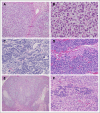Ovarian Sex Cord-Stromal Tumors
- PMID: 27858560
- PMCID: PMC5063189
- DOI: 10.1200/JOP.2016.016261
Ovarian Sex Cord-Stromal Tumors
Abstract
Ovarian sex cord-stromal tumors are clinically significant heterogeneous tumors that include several pathologic types. These tumors are often found in adolescents and young adults and can present with hormonal manifestations as well as signs and symptoms of a pelvic mass. Serum tumor markers may assist in preoperative diagnosis and surveillance. Several subtypes are associated with genetic predisposition, including those observed in patients with Peutz-Jegher syndrome. Recent studies have elucidated the relationship between Sertoli-Leydig cell tumors and DICER1 mutations. When classified as International Federation of Gynecology and Obstetrics stage Ia, most subtypes may be treated with surgery alone. Higher stage or recurrent tumors have variable prognoses that range from a usually rapid course in poorly differentiated Sertoli-Leydig cell tumor to an often prolonged course in adult granulosa cell tumors. New understanding of the molecular pathogenesis of these tumors may pave the way for novel therapeutics.
Figures

Comment in
-
Study of Infrequent Tumors: Sustained Commitment Necessary.J Oncol Pract. 2016 Oct;12(10):949-950. doi: 10.1200/JOP.2016.016907. J Oncol Pract. 2016. PMID: 27858563 No abstract available.
-
Ovarian Sex Cord-Stromal Tumors: The Challenge of Rare Gynecologic Malignancies.J Oncol Pract. 2016 Oct;12(10):947-948. doi: 10.1200/JOP.2016.016998. J Oncol Pract. 2016. PMID: 27858568 No abstract available.
References
-
- Morowitz M, Huff D, von Allmen D. Epithelial ovarian tumors in children: A retrospective analysis. J Pediatr Surg. 2003;38:331–335, discussion 331-335. - PubMed
-
- Schneider DT, Calaminus G, Wessalowski R, et al. Ovarian sex cord-stromal tumors in children and adolescents. J Clin Oncol. 2003;21:2357–2363. - PubMed
-
- Motoyama I, Watanabe H, Gotoh A, et al. Ovarian Sertoli-Leydig cell tumor with elevated serum alpha-fetoprotein. Cancer. 1989;63:2047–2053. - PubMed
-
- Kurman RJ, Carcangiu ML, Herrington S, et al. World Health Organization Classification of Tumors of Female Reproductive Organs. Lyon, France: IARC Press; 2014. , pp 18-21.
-
- Young RH. Sex cord-stromal tumors of the ovary and testis: Their similarities and differences with consideration of selected problems. Mod Pathol. 2005;18:S81–S98. (suppl 2) - PubMed
Publication types
MeSH terms
Grants and funding
LinkOut - more resources
Full Text Sources
Other Literature Sources
Medical

